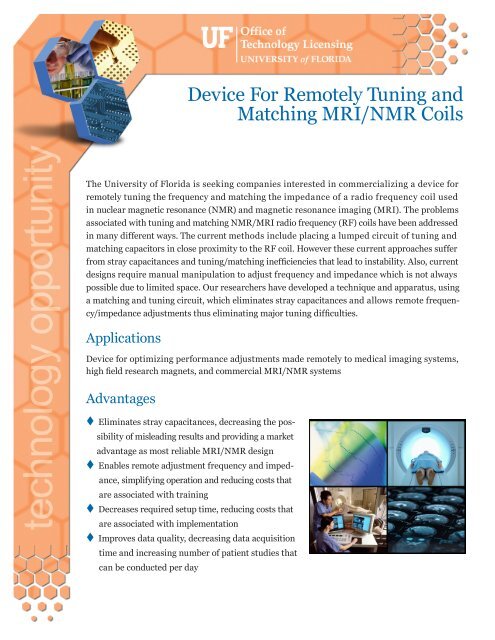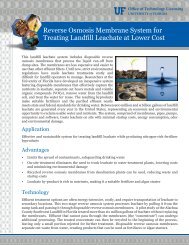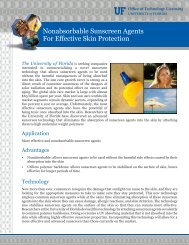Device For Remotely Tuning and Matching MRI/NMR Coils
Device For Remotely Tuning and Matching MRI/NMR Coils
Device For Remotely Tuning and Matching MRI/NMR Coils
You also want an ePaper? Increase the reach of your titles
YUMPU automatically turns print PDFs into web optimized ePapers that Google loves.
<strong>Device</strong> <strong>For</strong> <strong>Remotely</strong> <strong>Tuning</strong> <strong>and</strong><br />
<strong>Matching</strong> <strong>MRI</strong>/<strong>NMR</strong> <strong>Coils</strong><br />
The University of Florida is seeking companies interested in commercializing a device for<br />
remotely tuning the frequency <strong>and</strong> matching the impedance of a radio frequency coil used<br />
in nuclear magnetic resonance (<strong>NMR</strong>) <strong>and</strong> magnetic resonance imaging (<strong>MRI</strong>). The problems<br />
associated with tuning <strong>and</strong> matching <strong>NMR</strong>/<strong>MRI</strong> radio frequency (RF) coils have been addressed<br />
in many different ways. The current methods include placing a lumped circuit of tuning <strong>and</strong><br />
matching capacitors in close proximity to the RF coil. However these current approaches suffer<br />
from stray capacitances <strong>and</strong> tuning/matching inefficiencies that lead to instability. Also, current<br />
designs require manual manipulation to adjust frequency <strong>and</strong> impedance which is not always<br />
possible due to limited space. Our researchers have developed a technique <strong>and</strong> apparatus, using<br />
a matching <strong>and</strong> tuning circuit, which eliminates stray capacitances <strong>and</strong> allows remote frequency/impedance<br />
adjustments thus eliminating major tuning difficulties.<br />
Applications<br />
<strong>Device</strong> for optimizing performance adjustments made remotely to medical imaging systems,<br />
high field research magnets, <strong>and</strong> commercial <strong>MRI</strong>/<strong>NMR</strong> systems<br />
Advantages<br />
t Eliminates stray capacitances, decreasing the pos-<br />
sibility of misleading results <strong>and</strong> providing a market<br />
advantage as most reliable <strong>MRI</strong>/<strong>NMR</strong> design<br />
t Enables remote adjustment frequency <strong>and</strong> imped-<br />
ance, simplifying operation <strong>and</strong> reducing costs that<br />
are associated with training<br />
t Decreases required setup time, reducing costs that<br />
are associated with implementation<br />
t Improves data quality, decreasing data acquisition<br />
time <strong>and</strong> increasing number of patient studies that<br />
can be conducted per day
Technology<br />
This approach uses a combination of <strong>NMR</strong> coil reactance <strong>and</strong> cable impedance, all grounded to<br />
create a purely resistive match <strong>and</strong> eliminate stray capacitances. This circuit, called the matching<br />
tuning (M-T) box circuit, greatly improves tuning/matching efficiency, <strong>and</strong> is especially effective<br />
at high fields with varying sample loads, <strong>and</strong> where space considerations are paramount. It also<br />
allows for enhanced frequency <strong>and</strong> impedance adjustments to be made remotely when space for<br />
accessing the mechanical matching components is limited or not available.<br />
The Inventors<br />
Melvin Daniel Clark, Ph.D., is a senior engineer at the McKnight Brain Institute at the<br />
University of Florida. He designs, builds <strong>and</strong> tests radio frequency coils for the many <strong>NMR</strong> <strong>and</strong><br />
<strong>MRI</strong> high-field research magnets at the University of Florida <strong>and</strong> the National High Field Magnet<br />
Laboratory at Florida State University. Prior to joining the University of Florida, Clark was<br />
a research engineer with the Bioscience Division, Los Alamos National Laboratory, a research<br />
engineer at the University of Alabama Center for Nuclear Magnetic Resonance, an avionic engineer<br />
at the Hayes International Aircraft Corp in Birmingham, Ala., <strong>and</strong> a research <strong>and</strong> design<br />
engineer at the Spacecraft Incorporated in Huntsville, Ala.<br />
John R. <strong>For</strong>der, Ph.D., is an associate professor of Radiology at the McKnight Brain Institute<br />
at the University of Florida. He received his B.A. in Biology from the University of Vermont <strong>and</strong><br />
his Ph.D. in Pharmacology from the University of Michigan.<br />
Contact:<br />
Elizabeth Garami<br />
University of Florida<br />
Office of Technology Licensing<br />
(352) 392-8929 • egarami@ufl.edu<br />
UF #12303 Patent Pending






